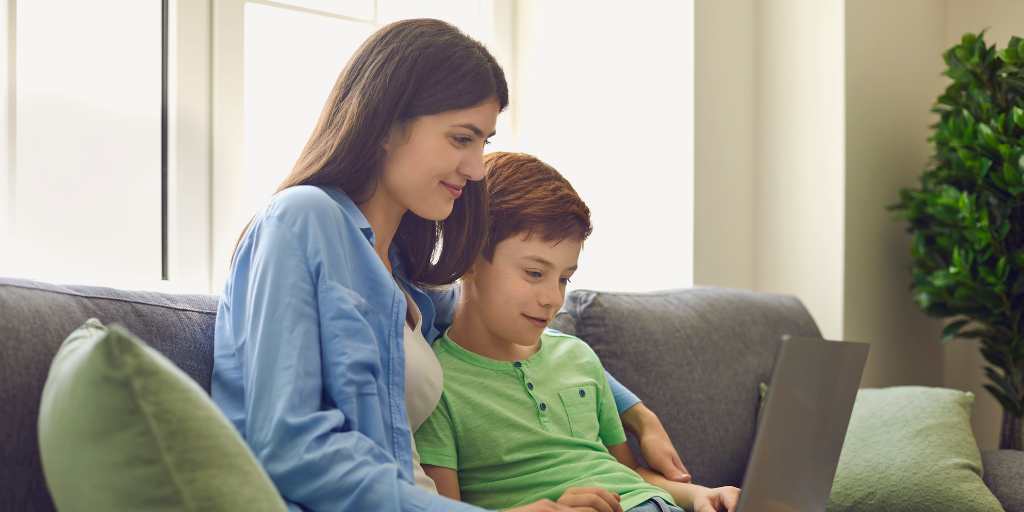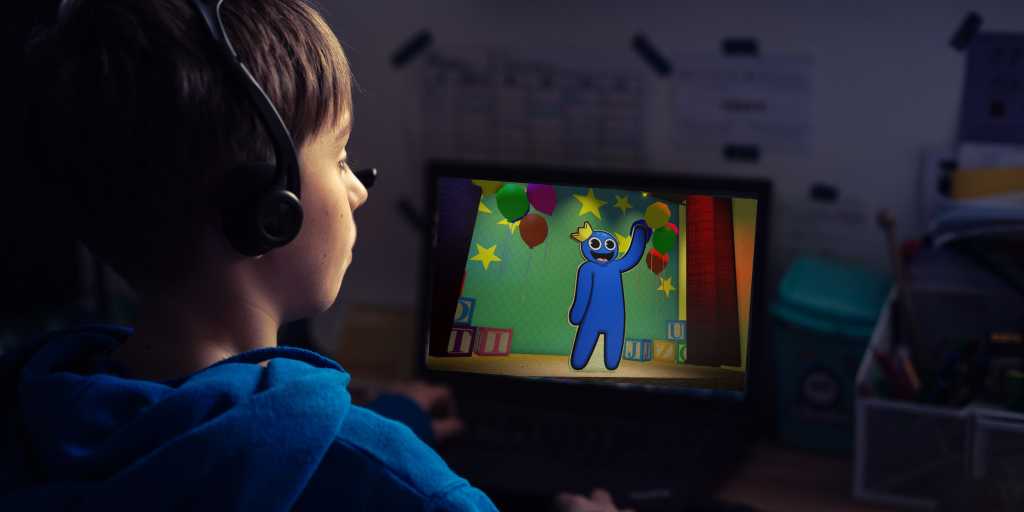
It will come as no surprise to parents that YouTube is all the rage with kids. In fact, recent research suggests that nine out of 10 kids use YouTube, and kids under 12 favor YouTube over TikTok. With all of YouTube’s popularity, how can you make the platform safer for your child? Read on to learn how to set parental controls on YouTube.
As the name implies, YouTube is a platform for user-generated content. While this creates an environment ripe for creativity, it also means there’s a little bit of everything, including videos featuring violent and sexual content, profanity, and hate speech.
Because YouTube makes it easy for kids to watch multiple videos in a row, there’s always the chance your child may accidentally land on inappropriate content. In addition, the comments section on YouTube videos are often unmoderated and can be full of toxic messages and cyberbullying.
Due to the risks, it’s important that parents monitor their child’s YouTube usage, discuss the risks with them, and use parental controls to minimize the chance they’re exposed to harmful content.
YouTube offers a variety of options for families looking to make their child’s viewing experience as safe as possible. Here are some important steps parents can take:
A supervised account will allow you to manage your child’s YouTube experience on the app, website, smart TVs, and gaming consoles.
There are three content setting options to choose from:
Along with content settings, here are some additional YouTube parental controls to explore:
For step-by-step instructions for setting up parental controls, refer to this comprehensive guide by YouTube.
While YouTube offers an impressive array of parental control settings, you have to manually review your child’s content and watch history in order to catch any concerning content.
BrightCanary is a parental monitoring app that fills in the gaps. Here’s how BrightCanary helps you supervise your child’s YouTube activity:
For parents looking for additional peace of mind, YouTube Kids provides curated content designed for children from preschool through age 12.
For households with multiple children, parents can set up an individual profile for each child, so kids can log in and watch videos geared toward their age. YouTube Kids also allows parents to set a timer of up to one hour, limiting how long a child can use the app.
Parents should be aware that switching to YouTube Kids isn’t a perfect solution. There’s still a chance that inappropriate content may slip through the filters.
In fact, a study by Common Sense Media found that 27% of videos watched by kids 8 and under are intended for older audiences. And for families concerned about ads, YouTube Kids still has plenty of those — targeted specifically toward younger children. Keeping an eye on what your child is watching and talking to them about inappropriate videos and sponsored content is still a good idea even with YouTube Kids.
It’s also worth noting that kids under 12 who have a special interest they want to pursue may find YouTube Kids limiting. A child looking to watch Minecraft instructional videos or do a deep dive into space exploration, for example, can find a lot more options on standard YouTube — plenty of which are perfectly appropriate for kids, even if they aren’t specifically geared toward them. It’s cases like this where parental controls and active monitoring with BrightCanary are especially useful.
YouTube is a popular video platform with plenty to offer kids. It’s not without risks, though. Parents should monitor their child’s use and take advantage of parental controls to ensure a safe, appropriate viewing experience.

What are your resolutions this year? Start an exercise routine? Learn a new skill? Make regular date nights an actual thing? As you write your list for 2024, don’t forget to include New Year’s resolutions for parents to help you keep your kids on track with reasonable device use and a responsible social media presence.
Here are some suggestions to add to your 2024 resolution list:
Sit down with your child on a regular basis to look at their device. View some of the content they’re consuming, including their social media feeds with them. During your check-ins, talk to your child about how to use their values to inform responsible online decision making. Regular tech check-ins not only help you keep an eye on your child’s online activity, but they also set a precedent of open communication — making your child more likely to come to you if they run into a problem online.
Our kids are watching. And if they see us glued to our phones nonstop, it’s much harder to enforce reasonable device restrictions for them. Practices like no-phone zones, device “bedtimes,” and screen-free family dates are great ways to model appropriate digital behavior for our children.
Cyberbullying is an unfortunate reality of modern childhood — one that can have serious consequences for kids. But there are steps you can take to help your child navigate these tricky waters. For more information on talking to your child about cyberbullying, check out our comprehensive guide.
Digital device contracts are an effective way to enforce household expectations and help your children use technology safely and responsibly. You can download our customizable device contract template here. We suggest including things like daily time limits for devices, rules around websites they can visit, and the expectation they respond promptly to texts and calls from parents.
There’s no substitute for hands-on monitoring of your child’s online activity. But a service like BrightCanary can help fill in the gaps. Using advanced AI technology, BrightCanary scans your child’s text messages and online accounts, alerting you to concerning content so you can address it.
Between the parental controls already available on Apple and Android devices and the options available on specific apps, caregivers have a lot of ability to customize what their child can access online. For more information and platform-specific guides, check out our parental controls resource page.
It’s as important as ever to talk to kids about stranger danger, but much of the risk has moved online with as many as 20% of children contacted by an online predator last year alone. It’s never too early (or too late) to have the conversation. Here are some tips to get you started.
The start of a new year is the perfect time to set goals, establish new habits, and devise an action plan. While planning your 2024 goals, consider how you can play a more active role in your child’s online life, whether they’re getting their first phone or are already a pro at using their tablet. You’ve got this, parent!

It’s a familiar scene of modern parenting: your kid, hunched over their iPhone, furiously texting. You, dying to know what they’re saying. But should parents read their child’s text messages? If you decide to monitor your kid’s text messages on iPhone, how do you do it?
Texting can expose your child to various concerns, including phishing scams, harassment, and predators. This article will explore how to determine the level of oversight needed for your child’s text messages and share practical methods for monitoring them both effectively and respectfully.
Gen Z is notoriously averse to phone calls, with as many as 75% preferring to text instead. But with the popularity of this communication method comes a host of safety concerns. Parents need to understand the risks their children may encounter over text and take steps to help them stay safe. As you decide if you should read your child’s texts, here are a few factors to consider:
It’s wise to have some level of engagement with your child’s text messages, either by directly monitoring them or by regularly asking about their conversations.
Beyond the worst-case scenario of a predator, monitoring your child’s texts also helps you make sure their peer relationships are healthy, the content they’re viewing is age-appropriate, and that they’re not up to trouble.
Holding the reins too tightly inhibits your child’s ability to learn independence and valuable life skills, so it’s important to strike a balance between supervising and stifling.
Rather than reading every message (who has time for that?!), using spot-checks or a service that alerts you to concerning content gives your child freedom while ensuring you can spot any trouble.
Also, consider the privacy of those your child communicates with. If you find something alarming about another kid, you’ll have to decide how to alert their caregivers.
By now, parents are well aware of the dangers of social media. But the reality is that texting exposes kids to plenty of concerning material as well. Here are some of the dangers parents need to be aware of:
By now, you might be wondering, “Okay, texting is risky. But how do I see my child’s text messages on iPhone?” There are a few different ways.
If your child uses an iPhone, you can log into their iCloud account on another device and see all of their messages. However, you’ll have to manually skim through each of their messages to find any red flags.
With BrightCanary text message monitoring, advanced technology automatically flags concerning material, such as explicit language, alcohol and drug references, and more. You can also monitor your child’s social media and YouTube accounts from your phone.
Other apps promise to let you see your child’s text messages, but many of them aren’t very reliable or easy to use.
For example, Bark requires that you install a desktop app on your home computer, then plug in your child’s phone. You can only monitor text messages on iPhone when your child’s device is home and on the same Wi-Fi as your computer.
BrightCanary is different. Simply log into your child’s iCloud account, and the app will automatically begin monitoring new text messages sent to your child’s device — including group chats and deleted texts. Download BrightCanary here to get a free trial.
Using Apple Family Sharing, you can establish limits on who your child messages and when. You can also set parental controls that perform a variety of safety tasks, such as blurring images that contain nudity and turning on location sharing.
Monitoring apps and parental controls are useful, but they’re only part of the puzzle. The most reliable method for monitoring your child’s texts is to look at their messages and talk to them about their experience.
The best thing you can do to keep your kid safe is to establish a framework of mutual trust. The specific details of how, when, and if you monitor their text messages is less important than open, honest communication.
Here are some tips for broaching the topic:
Don’t spy on your child’s texts. If they find out you’ve invaded their privacy without their knowledge, they’re less likely to come to you if they’re in trouble.
Instead, let them know your plan beforehand. Explain when and why you’re going to review their text messages. They may not like it, but at least they won’t feel like you went behind their back.
If you’re stumped, consider this conversation starter: “I respect your privacy, but I also need to make sure you’re safe. Here are the situations where I may need to look at your messages.”
Be upfront about how and when you’ll read your child’s text messages and what you’re looking for. You should also be clear about your red-flag concerns, such as suicidal thoughts, bullying, and involvement with a predator.
Let them know that if you find anything worrisome, you’ll address the issue together.
After you’ve established a plan for monitoring your child’s messages, consider writing it into a digital device contract. This will solidify expectations on both sides and help create accountability.
Given the risks facing kids on text, parents should treat this space with the same caution they do social media and device use.
Here are some ways you can help your child stay safe when texting:
Talk to your child about things like online predators, explicit messages, and cyberbullying. Help them learn to identify troubling messages and encourage them to come to you for help if they receive any.
Be clear with your child that you are a safe space and they can come to you for unconditional support and help if they run into trouble.
Regularly sit with your child and look at their messages together. Make these reviews a condition of them having a device. Set this expectation with them ahead of time so they don’t feel blindsided. Let them know you’re on their side and be clear that you looking at their messages isn’t a punishment — it’s a way to keep them safe.
The safest chat apps, such as Messenger Kids and Kinzoo, don’t allow strangers to message your child. This limitation minimizes some concerns, but it’s still a good idea to play a hands-on role in monitoring their messages.
Deciding when to stop checking your child’s phone largely depends on their individual maturity level and the trust you’ve established with them. As children grow and demonstrate responsible behavior, it’s essential for parents to gradually grant more privacy to foster independence.
It’s a good practice to maintain open communication with your child about this topic and adjust your approach based on their development and the unique dynamics of your relationship.
You can monitor your child’s text messages and social media messages on Android using Google Family Link.
While texting is a wonderful way for kids to maintain friendships and exercise their independence, there are a number of concerns parents should recognize. It’s advisable to maintain some level of involvement in your child’s text messages, using a combination of monitoring and open communication.

The BrightCanary Breakdown series distills research about kids, the internet, and social media into essential takeaways.
A recent study by the University of Michigan C.S. Mott Children’s Hospital (C.S. Mott) surveyed parents of children ages 0-4 about how they use social media to discuss their children and share ideas related to parenting.
Many parents reported that social media is a useful parenting resource. However, the vast majority of parents (72%) also identified at least one aspect of social media sharing that worries them, including privacy issues.
What strategies do parents use to mitigate the risks of posting about their kids on social media? And what can the rest of us learn from the results?
Here’s what the study found.
In August 2023, C.S. Mott enlisted Ipsos Public Affairs, LLC (Ipsos) to conduct a nationally representative household survey. The survey was administered to a randomly selected group of parents with at least one child aged 0-18 living in their household.
C.S. Mott then compiled a report based on responses from 614 parents with at least one child aged 0-4.
Because the study data was based on self-reporting, there’s a risk of response bias. It’s unclear from the report if any measures were taken to mitigate this risk.
The study found that a majority of parents (57%) use privacy settings to restrict who can see their posts. About 30% of respondents avoid posting photos or videos of their child altogether, while an additional 5% block out their child’s face.
Other measures that parents report taking to address privacy concerns include only participating in closed groups (22%) and using their child’s initials instead of their name (5%). One-third (31%) of parents report not discussing their child at all on social media.
There are many compelling reasons for parents to limit social media sharing about their children.
For one, the rapid rise of artificial intelligence brings with it the very real concern that images posted on social media can be used for nefarious purposes such as deepfakes. In addition, pictures of children may attract the attention of child predators.
Another issue for parents to consider is their child’s autonomy. Posting pictures of children contributes to their digital footprint when they’re still too young to make their own decisions about their online presence.
Here are some actions parents can take to address privacy concerns related to their child’s social media presence:
Research by the University of Michigan C.S. Mott Children’s Hospital reveals parents’ concerns over the privacy and safety of their children on social media. Parents can proactively address these concerns by teaching their children about the importance of carefully considering what they post and setting their own and their child’s accounts to private.

Even if you’ve never heard of sadfishing, you’ve probably seen it. It’s the teary-eyed selfie with a vague caption like, “Why is this happening to me?” Or the lengthy overshare that feels uncomfortable to read. It’s usually followed by scores of supportive comments.
Sadfishing isn’t uncommon among tweens and teens, but as a parent, it’s hard to know how to react to this behavior. Read on to learn how to differentiate between attention-seeking behavior and a genuine cry for help, along with tips on discussing sadfishing with your child.
Sadfishing refers to social media posts intended to solicit sympathy. The sadfish meaning comes from phishing, an online tactic where someone attempts to “fish” information from a person in order to scam them. With sadfishing, the goal is to catch sympathy, not personal data.
While teens and tweens who sadfish may be exaggerating their emotions, it’s important not to dismiss these posts out of hand. Underneath the overly dramatic optics are usually real emotions and a genuine need for support. The poster simply may not have the tools to seek attention and support in a more effective way.
Sadfishing takes many forms: posts, stories, direct messages, and group chats. It includes original posts, as well as sharing sad posts from others and indicating it applies to themselves as well. The language is often intentionally vague, but it can also involve emotional oversharing. For example, you might review their activity on your child safety app and notice that they’re looking at a lot of depression memes on Instagram.
It’s important to note that not every post your kid makes about a hard topic is sadfishing. If they break their arm and post a selfie of their arm in a cast, for example, they’re most likely just sharing their life with their friends.
Behavior crosses into sadfishing territory when posts become a pattern or when the intensity of the post doesn’t match up with what you’re seeing in their life. Another possible sign of sadfishing is when your child obsessively checks for comments and likes on their post.
It’s a good idea to talk to your child about sadfishing, even if they aren’t engaging in this behavior.
Here are some talking points to consider:
Sadfishing exists on a continuum from mild to serious. If you discover your child is participating in this behavior, the first thing to do is determine the level of seriousness so you can act accordingly.
Here are three levels of sadfishing and how to respond:
When your child makes frequent and vague sadfishing posts, but there’s nothing big happening in their life and they seem fine otherwise, they may be in need of attention but don’t know other means to seek it.
Some ways to address this are setting aside more time to spend with them, being intentional about demonstrating your interest in their lives, and helping them organize regular get togethers with friends.
When your child’s posts involve oversharing or dwelling on a negative topic and differ from their regular posts, they may need direct support in a particular area. Perhaps they’re having trouble in school or with friends. Talk to them about their posts, offer your support, and inquire about areas of their life where they may be struggling.
If your child’s posts reference self-harm, suicide, or other extreme behavior, it’s important to take prompt action. Seeking expert guidance and engaging the help of a mental health professional is strongly advised. The National Suicide Hotline is also an excellent resource.
Sadfishing posts are intended to seek sympathy and support. They can range from mild attention seeking to serious cries for help. Parents should talk to their kids about sadfishing and keep an eye out for this behavior so they can address it accordingly.
If your child is experiencing suicidal thoughts or a mental health crisis, please reach out immediately to the Suicide Prevention Lifeline at 800-273-8255 or by texting or calling 988 from a cell phone. These services are free and confidential.

Winter break: that time of the year when we bake cookies and wrap presents and … listen to our children beg for extra screen time. (Or is that just me?) If you’re dreading the impending device battles when your child is out of school, you’re not alone. Read on for ideas on how to handle school holiday screen time rules.
Consider your family’s plans for the break and decide on your priorities. Perhaps you have family coming to visit, and it’s important to you that your kids not be glued to their screens while Grandma’s here. Or maybe you cherish certain seasonal activities like playing in the snow or decorating a Christmas tree.
The screen-free activities you want to prioritize during this time of year can serve as a framework for making screen time decisions. That way you’re plugging in screen time around the things you value, creating a sense of adding on, rather than taking away.
As a parent, it’s easy to view screen time as a necessary evil. But for many kids, it can be a valuable rest for their brain.
As adults, we often unwind from a long day in front of the TV or playing a game on our phone, and kids are no different. Recognizing that a little extra screen time during break may help your child return to school refreshed can help reframe the issue for you.
Consider using screen time as an opportunity to teach your child about their brain. Mention how hard they’ve been working at school and that you’re letting them have some extra screen time as a brain break. Couple this with a discussion about additional ways they can unwind, such as reading or playing.
Screen time habits are best viewed as a whole, not by looking at one slice of time. If you’ve decided to be more lenient with devices over break, try to let go of any accompanying guilt. The limits you set on a regular basis are more important than what happens on any individual day.
By the same token, if you feel it’s best to stick with your regular screen time limits during break, that’s okay, too. You don’t have to give your kids extra screen time when they’re out of school just because their friends get it. Do what’s right for your family.
Experts are clear that not all screen time is created equal. The AACAP recommends encouraging using screens in ways that build connections with family and friends. Family movie night or playing video games with a sibling are two ideas for using screens to foster togetherness.
As with most things in life, moderation is the key. Rather than giving your kids carte blanche over their devices, adjust the limits you already have in place. It’s best to remain firm on things like screen-free zones and no-device times, such as family meals.
From ice skating to gingerbread houses to marathon reading sessions, winter break is the perfect time for fun activities that are hard to fit in during school. If you give your kids plenty of options that don’t involve a screen, you might even find they don’t use all their extra device time at all.
Going into break, sit down as a family and talk about what screen time will look like while school is out. Explain that, while there may be some extra screen time, there will still be reasonable limits. If there are days during break where you anticipate no time for screens (such as a visit from relatives or a trip to the mountains), give your kids a heads-up. Most children can roll with things a lot better if they know what to expect.
Winter break is a fantastic time for engaging in some extra fun. A little additional screen time can be one piece of the pie, but make sure to set clear expectations and sprinkle in other activities as well.

You knew this time would come, and now the day is finally here: your kid’s first phone. Before you wrestle with the wrapping paper, stick on a bow, and prepare yourself for preteen squeals of delight, there are some important things to do first. A first phone for kids is a big step, but with some proper planning, you’ll set them up for success by teaching healthy tech boundaries.
Be clear with your child that a phone is a big responsibility and that your job as a parent is to provide them with the guardrails they need to learn how to manage it.
The rules and expectations you set will depend on your child’s age and maturity level, as well as your family values. Some common rules involve when and where the phone can be used, what it can be used for, and who it can be used to communicate with.
A phone opens up a whole new world of independence, and with that comes the need to focus on safety. Emphasize the importance of not making their number widely available and only talking and messaging with people they know. This is also a great time to discuss staying safe from online predators.
Regular tech check-ins are a great way to keep tabs on what your child is doing on their phone. It’s also helpful to establish clear lines of communication so they feel comfortable coming to you for help if they run into trouble.
Sit down with your child on a regular basis to look at their phone together. Check out things like text messages, browser history, and apps.
In the beginning, it helps to put these check-ins on the calendar until it becomes a habit. Even if your child is tempted to hide some material when they know a check-in is coming, some oversight is better than nothing.
While there’s no substitute for the hands-on approach of regular tech check-ins, it’s also impossible for parents to catch everything. That’s where a service like BrightCanary is a lifesaver.
BrightCanary uses AI technology to scan your child’s activity on YouTube, Google, TikTok, and Instagram. The app alerts you to any red flags that need your attention, so you can talk about them together.
Before you hand over their shiny new phone, set up an account on BrightCanary and explain to your kids why and how it will be used.
If your child is already using a tablet or other device, you’ve likely already set some rules around where and when that device can be used. But the portable, fits-in-your-pocket nature of a phone can make it tempting to pull their phone out at any time and place. Emphasize that the same screen-free times and zones apply to their phone. For example: no devices in the bedroom, at the dinner table, or in the car.
Take advantage of the parental controls built into your child’s new phone. The options will vary depending on the device, but a few to look for are screen time limits, downtimes when the device can’t be used, content restrictions, and app restrictions.
Good news if you’re giving your kid an iPhone: Apple devices have robust parental controls that you can set up as soon as your child has their own iCloud account.
After you’ve decided on the rules and expectations around your kid’s new phone, write it into a digital device contract. This document helps make sure everyone is on the same page and emphasizes the importance of the things you’ve agreed upon.
Your child’s first phone can feel like a huge milestone. But it doesn’t have to be scary. Set yourself and your kid up for success by laying the groundwork ahead of time.

With all the talk about the dangers of too much screen time, it can be hard to know if a tablet is the right choice for your kid. And is an iPad for kids even safe? If you’re wondering if you should get your kid a tablet this holiday season, here are key pros and cons to help you make the decision.
As you decide if you should get your kid an iPad, one of the first things to do is to think about why you’re considering it and how you envision it being used.
Perhaps you’re looking for an easy-to-transport distraction for long car rides. Maybe you’re interested in educational apps for their enrichment potential. Or maybe you’re keen to make sure your child keeps up with their tech-savvy peers.
Identifying your motivation for getting a tablet for kids can help frame your decision as you weigh the pros and cons.
The American Academy of Pediatrics recommends no devices for children younger than two, with the exception of video chatting. Even if your child is old enough, that doesn’t necessarily mean an iPad is right for them.
Here are some questions to ask yourself aside from age:
While it’s always a good idea to maintain some level of supervision over your child’s iPad time, parental controls are an excellent compliment to your watchful eye. This guide from Apple gives step-by-step instructions for setting up parental controls.
Here are the main parental controls to look for:
You can also use a parental monitoring app, such as BrightCanary, to supervise your child’s browsing habits. BrightCanary uses advanced AI to monitor your child’s Google, YouTube, social media, and text message activity, and you’ll get an alert if your child encounters anything problematic.
It’s best to set rules around iPad use from the very beginning. Be clear with your child about expectations and if there are consequences for not following them.
The rules you set will depend on what’s right for your family, but here are some to consider:
Once you’ve established your family’s rules around iPad use, consider writing it into a digital device contract.
It’s important that parents consider both the pros and the cons before getting their child an iPad and establish clear expectations around its use. A tablet is a connected device, and as such, it can expose your child to the entire world of the internet. Parental control settings and monitoring apps can help give you peace of mind — and set a safety net for your child’s online experience. Stay connected to your child’s online activity with BrightCanary monitoring. You’ll be able to monitor their YouTube searches and posts, Google searches, and more, directly from your phone. Download the app today and start your free trial.

There’s no shortage of celebrity parents sharing the cute pictures and adorable antics of their offspring online. But this group of eight famous moms and dads stands out for their especially mindful approach to digital parenting. Their strategies range from rules about posting their children’s images to deciding if and when their kids can access the internet
As parents, we often spend a lot of effort monitoring our kid’s digital lives, but it’s also important to be considerate of our own online choices. Our kids are watching, after all. It’s this intentional approach to parenting and social media that we love most about Chrissy Teigen.
Once dubbed the “Queen of Social Media,” Teigen is known for being especially personal with what she shares. But for all her openness online, Teigen refuses to post anything about her kids that might embarrass them one day. We love when parents are respectful of their children’s digital footprint.
In recent years, Kate Winslet has become a fierce advocate for stricter enforcement of social media age limits. Winslet cites the impact of social media on children’s mental health as she calls for the government to step in and make platforms increase their security checks to ensure kids aren’t skirting the rules on age.
Jennifer Garner understands the pressure to let kids use social media — especially when their friends are all online. But she’s made the intentional decision not to let her kids open accounts just yet. She talks openly about the pressures kids face on social media (even when they don’t have famous parents) and how she wants to insulate her kids from that for the time being. We might not all make the same decision as Garner, but we can all appreciate the importance of thoughtfully considering our digital parenting decisions.
Celebrities: they’re just like us. Well … Victoria Beckham may exist on a different plane than the rest of us mere mortals, but she definitely relates to being terrified of her kids joining social media. And, in an effort we particularly appreciate, she and husband David Beckham monitor every post their son Brooklyn makes now that he’s joined the ranks of the digitally connected.
Ryan Reynolds understands the importance of setting screen-free times at home. He shuts down all devices at three specific times each day in order to be fully present with his kids and his wife, Blake Lively. We love the way this not only fosters connections, but also sets a great example for kids. Way to go, Dad!
We love so many things about the way Kristen Bell parents in the digital age, including her and her husband Dax Shepard’s decision to not post their kids’ faces on their own very public social media accounts. But it was her recent sharing of this post on her Instagram stories that really got us thinking. She used the share to encourage parents to look their children in the eyes and show them that “they deserve more respect and dignity than a fancy metal box.” Oof. That one really hits home.
Alanis Morisette uses her platform to encourage her audience to develop greater connections, including speaking on panels about conscious communication in the digital age. But it was the video for her song, “Ablaze,” featuring distinctly analog moments of family connection and a message about supporting our kids to be the best versions of themselves that had everyone on the BrightCanary team tearing up — some of us (who me?) multiple times.
When it comes to striking a balance with kids and technology, Gisele really gets it. While she acknowledges that technology can bring about connection, she also cautions that it should be used in moderation. It’s because of this that she limits her childrens’ iPad time and encourages them to get outside instead. She also has a strict no gadgets at the dinner table rule. “This is a time we use to reconnect and catch up about our day,” Gisele said in an interview with Marie Claire.

Roblox, a popular gaming platform, is known for captivating millions of kids with its engaging user-generated experiences. One Roblox game which has garnered particular attention of late is Rainbow Friends. But not all of the attention has been positive, leaving many parents questioning: Is Rainbow Friends for kids? Or should I steer my kiddo away from this one?
At BrightCanary, we believe that information is key to making smart digital parenting choices. Use our Roblox Rainbow Friends review to decide if this game is appropriate for your child.
In Rainbow Friends, players assume the roles of kids on a seemingly innocent field trip. However, upon arrival, they find themselves trapped in an abandoned amusement park. To survive, they must complete various tasks, all while evading the colorful yet eerie creatures that hunt them.
Roblox lists Rainbow Friends as appropriate for all ages with mild, occasional violence. But this age designation may not be accurate, and people online have shared that a higher age rating is more appropriate. Our advice is that parents should exercise caution, especially for younger children.
While it’s true that the violence is both minimal and tame, Rainbow Friends is a horror game. The premise of a would-be joyful environment turned into a nightmare factory, combined with ominous music and a foreboding storyline, are clearly designed to be quite creepy.
Older kids are unlikely to be fazed, especially given the cartoonish nature of Roblox graphics, but younger children and those who are more sensitive may find themselves scared. Parents are advised to use their discretion and preview the game before deciding if it’s appropriate for their child.
There is no explicit language in Rainbow Friends. However, due to Roblox’s open-chat feature, it is possible your child might encounter inappropriate language from other users.
If this is a concern for you, check out our Roblox Parent’s Guide for information on how to lock down your child’s account and turn off chat.
Rainbow Friends doesn’t contain any nudity or sex. If that’s the primary concern for you when evaluating content for your child, you can rest easy.
For all its creepy atmosphere and sinister-looking creatures sneaking about promising danger around every corner, Rainbow Friends is quite light on actual violence. There isn’t really any blood and gore, and any violence is mostly suggested.
When a player is “found” by the monsters, they’re simply snatched away offscreen. Their username then appears with an X over it, which could be interpreted as the player being dead. But this is subject to interpretation and could easily go over the heads of younger kids.
So, is Rainbow Friends for kids? Roblox Rainbow Friends is a horror game with a premise and characters that some children may find frightening. However, it doesn’t contain any graphic violence. Older kids and children who are less sensitive aren’t likely to be affected. Consider sitting with your child the first time they play the game and check in with them to make sure they’re handling it well.
We always recommend that parents stay engaged with the content their kids consume, whether it’s a new video game, YouTube channel, or influencer. Is it appropriate for your child? Is it exposing your child to material they may not be ready to handle on their own? Stay connected to your child’s interests and online activity with BrightCanary. Made by parents, for parents, BrightCanary helps parents remotely monitor their children’s activity on YouTube, Google, Instagram, and TikTok. Download the app and get a free trial today.